Time has come, the route of the Tour de France 2026 has been officially presented, during the annual show at the Palais des Congrès in Paris, and although the bulk of the route was already known through the rumors you've been able to discover over the last month and a half here on velowire it's only on this occasion that we really discover the details of the different stages. And the least we can say is that, even if the finish in the Pyrenees comes quickly, it's the end of the Tour de France 2026 that has the biggest difference in altitude!
Let's discover the main points of this route, as well as the details of the different stages, and their profiles.
The Tour de France 2026 route in figures
As usual, let's start with the figures for the 113th Tour de France:What's new?
Abandoned for some time in favor of a single intermediate sprint on each stage of the Tour de France, the Tour de France 2026 will see the return of 2 intermediate sprints on each of the 7 flat stages, in order to open up new strategic options for the protagonists of the points classification.Another new feature is that the Tour de France 2026 will begin with a team time trial, something that hasn't been done since 1971 in Mulhouse, and this time team times will be taken from the first rider to cross the line, while individual times will be taken from the actual times of each rider. Finally, the Tour de France 2026 will be further south than the Tour de France has ever been before. Indeed, at the start of stage 2 in Tarragona 🇪🇸, the race will lie slightly south of the horizontal line that can be drawn from Bonifacio in Corsica, which held this record since the Tour de France's only passage over the island, at the Tour de France Grand Départ in 2013.
The stages of the 2026 Tour de France
CONTINUE READING AFTER THIS ADVERTISEMENT
The 21 stages of the 113th Tour de France
Here are the 21 stages of the 113th edition of the Grande Boucle, the Tour de France 2026 (you can click on a stage in this table to go directly to its description):| # | date | start | finish | distance/comments |
|---|---|---|---|---|
| 1 | sa. July 4, 2026 | Barcelona 🇪🇸 | Barcelona 🇪🇸 | 19 km - TTT |
| 2 | Sun. July 5, 2026 | Tarragona 🇪🇸 | Barcelona 🇪🇸 | 182 km |
| 3 | Mon. July 6, 2026 | Granollers 🇪🇸 | Les Angles | 196 km |
| 4 | ma. july 7, 2026 | Carcassonne | Foix | 182 km |
| 5 | me. July 8, 2026 | Lannemezan | Pau | 158 km |
| 6 | thurs. july 9, 2026 | Pau | Gavarnie-Gèdre | 186 km |
| 7 | Fri. July 10, 2026 | Hagetmau | Bordeaux | 175 km |
| 8 | sa. July 11, 2026 | Périgueux | Bergerac | 182 km |
| 9 | Sun. July 12, 2026 | Malemort | Ussel | 185 km |
| R1 | Mon. july 13, 2025 | rest day Cantal | ||
| 10 | Tue. july 14, 2026 | Aurillac | Le Lioran | 167 km |
| 11 | me. July 15, 2026 | Vichy | Nevers | 161 km |
| 12 | Thur. July 16, 2026 | Circuit Nevers Magny-Cours | Chalon-sur-Saône | 181 km |
| 13 | Fri. July 17, 2026 | Dole | Belfort | 205 km |
| 14 | sa. July 18, 2026 | Mulhouse | Le Markstein (Fellering) | 155 km |
| 15 | Sun. July 19, 2026 | Champagnole | Plateau de Solaison | 184 km |
| R2 | Mon. july 20, 2026 | rest day Haute-Savoie | ||
| 16 | ma. july 21, 2025 | Évian-les-Bains | Thonon-les-Bains | 26 km - ITT |
| 17 | Wed. July 22, 2026 | Chambéry | Voiron | 175 km |
| 18 | thurs. July 23, 2026 | Voiron | Orcières-Merlette | 185 km |
| 19 | Fri. July 24, 2026 | Gap | Alpe d'Huez | 128 km |
| 20 | sa. july 25, 2026 | Le Bourg d'Oisans | Alpe d'Huez | 171 km |
| 21 | di. July 26, 2026 | Thoiry | Paris Champs-Elysées | 130 km |
1/ Saturday, July 4, 2026 - Barcelona (Barcelona) 🇪🇸 > Barcelona 🇪🇸 - team time trial - 19 km
The Tour de France 2026 begins with a rather special exercise: a team time trial starting and finishing in Barcelona.While the first 15 km of this stage will be flat, the climb up the Côte de Montjuïc (1.1 km at 5.1%) and the finish at the Côte du Stade Olympique (800 m at 7%) will invite the riders to reveal themselves, and as the times for the overall individual classification will be taken in real time, i.e. as each rider passes, there's a risk that the strongest will give their team-mates the slip.
After setting off from the Fórum, the teams will first follow the coast to the Port Olímpic, before returning to the starting point on a street parallel to the one that brought them there. They will then head for the Sagrada Família, whose tallest tower will be inaugurated on June 10, 2026, the centenary of the death of architect Antoni Gaudí and just 3 weeks before the start of the Tour de France 2026. The teams then head for Plaça d'Espanya, where the game begins with the two difficulties that will mark this stage. As with the other 2 stages of the Grand Départ of the Tour de France 2026, you can already find all the details of this stage on velowire.com:
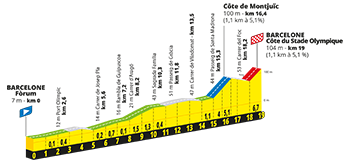
2/ Sunday, July 5, 2026 - Tarragona (Tarragona) 🇪🇸 > Barcelona 🇪🇸 - 182 km
The first stage in line, starting from Tarragona, will be one for the puncheurs. Here, too, the first half of the stage will be flat, but the riders will then have to climb the Côte de Begues (6.1 km at 6.5%), the Côte de Santa Creu d'Olorda (8.4 km at 4.5%) and, 3 times, the Côte du château de Montjuïc (1.6 km at 9.3%) and the Côte du Stade Olympique (600 m at 7%) in Barcelona.Logically, Montjuïc won't give birth to a mouse, and the Yellow Jersey could already change shoulders on this occasion.
3/ Monday, July 6, 2026 - Granollers 🇪🇸 > Les Angles
The Grand Départ of this Tour de France 2026 concludes with a start in Granollers. After an initial climb up the Côte de Sant Feliu de Codines (^ 622 m / 7.6 km at 4.5%), the Col de Toses summit is reached at around two-thirds of the way through the stage (^ 1,778 m / 9.3 km at 6.5%), the last 3 km of which have a gradient of between 9 and 10%.After the descent to Puigcerdà, the riders cross the border into France 40 km from the finish and climb first to Font-Romeu and its Col du Calvaire, before starting the ascent to the resort of Les Angles (1.7 km at 6.5%).
With this, this stage represents a positive vertical gain of 3,950 meters, but the stage finish is more likely to be won by a strong breakaway rider than a real climber, and therefore one of the big names in the overall classification.
- Discover in detail the 3rd stage of the Tour de France 2026 between Granollers and Les Angles, with a detailed map and the stage profile (the passage through Font-Romeu is not correctly represented)
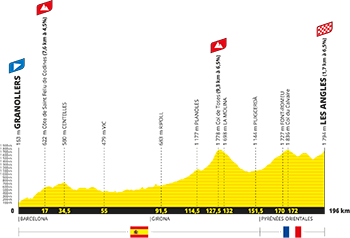
CONTINUE READING AFTER THIS ADVERTISEMENT
4/ Tuesday, July 7, 2026 - Carcassonne > Foix - 182 km
The Cité de Carcassonne will be back for the 14th time for the Tour de France, and this time it will be for the start of stage 4. This stage features 5 listed difficulties, including, in the second half of the stage, the Col de GoudonsCol de Montségur (^ 1,059 m / 6.9 km at 6.6%), the summit of which is some 35 km from the finish. Then, passing through Lavelanet, the riders head slightly downhill towards the finish in Foix. The positive altitude difference on this stage will be 2,750 meters, and the finish should take place at the foot of the Château de Foix.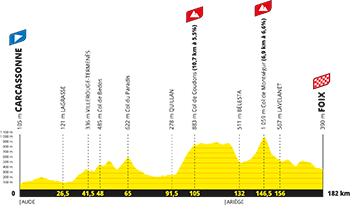
5/ Wednesday, July 8, 2026 - Lannemezan > Pau - 158 km
The 5th stage will be the first of this Tour de France 2026 to be reserved for sprinters, starting in Lannemezan and finishing only 158 km further on, in Pau. Pau, too, has already seen the Tour de France on numerous occasions, and will host the Tour de France for the 77th time in 2026. With Pau's new presence on the Tour de France map, the city comes dangerously close to Bordeaux for 2nd place in the ranking of cities that have hosted the Tour de France the most. For the time being, Bordeaux is still slightly ahead of the Tour de France, and it's a good thing Bordeaux is also on the Tour de France map, so they don't lose any more points!6/ Thursday July 9, 2026 - Pau > Gavarnie-Gèdre- 158 km
Starting from Pau, this 6th stage will be the real Pyrenean stage. After passing through Lourdes and Bagnères-de-Bigorre, the riders head for Arreau, where the hostilities begin with the ascent of the Col d'Aspin (^ 1,489 m / 12 km at 6.5%) and then the Col du Tourmalet Souvenir Jacques Goddet (^ 2,115 m / 17.1 km at 7.3%). After the descent of the last, they will then be at the foot of the final climb to Gavarnie-Gèdre (^ 1,380 m / 18.7 km at 3.7%) where it will be either the strongest climber of a possible breakaway or one of the strongest men in the overall classification (if they have launched hostilities to catch the breakaways before the summit of the Tourmalet) who will win this stage with its 4,150 meters of positive altitude difference.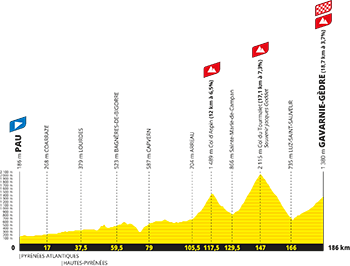
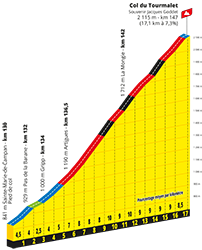
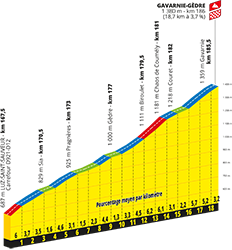
7/ Friday, July 10, 2026 - Hagetmau > Bordeaux - 175 km
Between Hagetmau and Bordeaux, there's no doubt about it: the sprinters' trains will be on the rails, so that the fastest of them wins this 7th stage. For Bordeaux, this will be the 82nd time the city has hosted the Tour de France!CONTINUE READING AFTER THIS ADVERTISEMENT
8/ Saturday, July 11, 2026 - Périgueux > Bergerac - 182 km
On this 8th stage, which takes place entirely in the Dordogne, between its prefecture Périgueux and Bergerac, there will also be a low positive altitude difference of 1,150 meters, and here too, there's a good chance that the stage will finish in a bunch sprint. The stage will be a near-perfect replica of the 2017 Tour de France, won by Marcel Kittel.9/ Sunday, July 12, 2026 - Malemort > Ussel - 185 km
This 9th stage will take place between two new Tour de France stage towns, starting in Malemort, a suburb of Brive-la-Gaillarde. This stage will take place entirely in the Corrèze department, and is sure to please the most adventurous riders. The first half of the stage is the most hilly, right up to the start of the second half, with the summit of Suc au May (^ 903 m / 3.8 km at 7.7%) reached after 105 kilometers. In the second half, the riders will find the climb to the highest point in the Corrèze department, Mont Bessou (^ 977 m). The stage ends with a 24-kilometer toboggan descent to the town of Ussel. This stage will have a total vertical gain of 3,300 metres.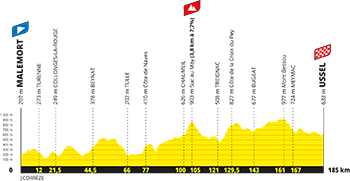
R1/ Monday July 13, 2026 - rest in Cantal
After a transfer, the riders will be able to rest after the first 9 stages of the Tour de France 2026, in the Cantal department of France.10/ Tuesday, July 14, 2026 - Aurillac > Le Lioran - 167 km
The Cantal department has a lot to offer in terms of elevation gain, and this will be evident on this 10th stage, which departs from Aurillac, the Cantal prefecture, on Bastille Day. The race leaves Aurillac to the south, heading for Marcolès, famous for its critérium cycliste which takes place shortly after the Tour de France. The stage will feature a total of 7 listed cols and côtes, starting at around kilometer 65: Côte de Pailherols (^ 1,043 m), Col de la Griffoul (^ 1.336 m / 5.9 km at 6.7%), never before climbed during the Tour de France, the Col de Prat de Bouc (^ 1,392 m), the Côte de Murat (^ 1,193 m), the Puy Marie-Pas de Peyrol (^ 1,589 m / 7.8 km at 6%), the Col de Pertus (^ 1,309 m / 4.4 km at 8.5%) and the Col de Font de Cère (^ 1,294 m). This is followed by a short descent and final climb to Le Lioran (^ 1,242 m). The total climb on this stage is 3,900 metres.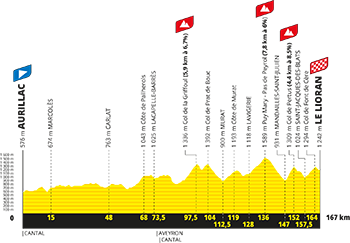
CONTINUE READING AFTER THIS ADVERTISEMENT
11/ Wednesday July 15, 2026 - Vichy > Nevers - 161 km
After the collection of difficulties on the July 14 stage, this 11th stage will be quite different. It sees the Tour de France return to Vichy, which hasn't seen the Grande Boucle since 1952, and is therefore only the second time the Tour de France has stopped here! It will be a sprinters' stage, finishing in Nevers, with the two intermediate sprints in Moulins and La Machine.12/ Thursday, July 16, 2026 - Circuit Nevers Magny-Cours > Chalon-sur-Saône - 181 km
The following day will also be a sprinter's stage for the Tour de France 2026, with a start from the Circuit Nevers Magny-Cours, which had already seen a time trial start of Paris-Nice this year. In Chalon-sur-Saône, there will be no motor racing circuit, but speeds reaching those of our everyday vehicles, for a massive sprint that will decide the winner of this 12th stage.13/ Friday, July 17, 2026 - Dole > Belfort - 205 km
For the 3rd time in 10 years, the Tour de France will come to Dole for the start of this 13th stage. At 205 kilometers, it will be the longest stage of the Tour de France 2026, and the only one to exceed the 200 kilometer mark. The race will pass through the departments of Jura, Doubs, Haute-Saône, Vosges and Territoire de Belfort, the town which gives its name to this department. The profile of this stage may smile on the adventurers, but it's only in the last part of the stage, climbing the Ballon d'Alsace, that they'll really be able to express themselves.14/ Saturday, July 18, 2026 - Mulhouse > Le Markstein (Fellering) - 155 km
This 14th stage from Mulhouse has a completely different profile. To begin with, the riders will climb the Grand Ballon (^ 1,336 m / 21.5 km at 4.8%), the highest point of the stage. They then cross the finish line quickly after the first time, but several difficulties still lie ahead before the winner of this stage is known. A descent to Kruth brings them to the foot of the next difficulty, the Col du Page (^ 959 m / 9.8 km at 4.7%), and soon after the descent they climb the Ballon d'Alsace (^ 1,173 m / 8.9 km at 6.9%). A little further on, they'll find the Col du Hundsruck (^ 748 m) and then they'll discover a climb never seen before in the Tour de France, the Col du Haag (^ 1,233 m / 11.2 km at 7.3%), a forest road converted into a cycle lane, with a particularly irregular climb ... which will be just 6 kilometers from the finish at Le Markstein (^ 1,192 m).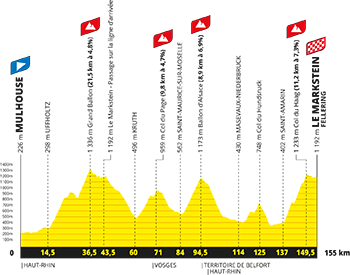
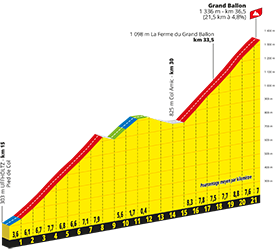
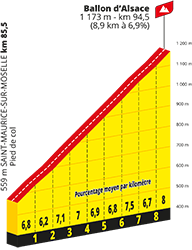
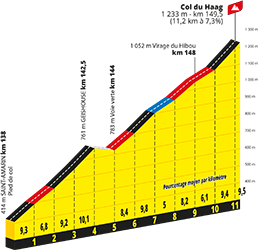
CONTINUE READING AFTER THIS ADVERTISEMENT
15/ Sunday July 19, 2026 - Champagnole > Plateau de Solaison - 184 km
After a long transfer, the Tour de France 2026 resumes the next day in Champagnole, known from a stage finish of the Tour de France in 2020. This time Champagnole resumes its role as starting town, as it had twice before. The stage will then cross the Jura and Ain departments. When the race enters the Haute-Savoie department, the roads rise to climb the Salève - Col de la Croisette (^ 1,175 m / 4.7 km at 11.2%), which will be back on Tour de France roads for the first time since 1992. And that's not all: the final climb still awaits the riders, and it too is highly selective. A first on the Tour de France route, it is the Plateau de Solaison (^ 1,508 m / 11.3 km at 9.1%).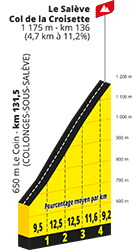
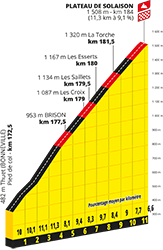
R2/ Monday July 20, 2025 - rest in Haute-Savoie
After a second week of racing, the riders of the Tour de France 2026 rest again, in Haute-Savoie, and more precisely in Thonon-les-Bains.16/ Tuesday, July 21, 2026 - Évian-les-Bains > Thonon-les-Bains - individual time trial - 26 km
On this Tuesday, July 21, 2026, the only individual time trial of the Tour de France 2026 is scheduled to start and finish on the shores of Lake Geneva.After the start in Évian-les-Bains, the individual time trial begins with a climb up to the Côte de Larringes (^ 799 m / 9.7 km at 4.3%), whose descent to the Pont de la Douceur takes each rider to a plateau, where they remain until the finish in Thonon-les-Bains. The stage is therefore perfectly balanced for a good rouleur, with one third uphill, one third downhill, one third flat. In 1926, Évian-les-Bains hosted the very first start of the Tour de France outside the Paris region. The 100th anniversary of this event will be celebrated on the occasion of the Tour de France 2026.
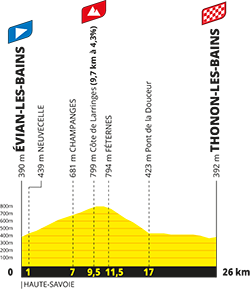
17/ Wednesday, July 22, 2026 - Chambéry > Voiron - 175 km
Even if this stage from Chambéry doesn't have a flat profile, it's more for sprinters ... who are still here in the 3rd week of the race! There's no doubt that those who remain will have no trouble climbing the few climbs on the course. Then it's off to the sprints, as the last 30 km of the stage will be all flat up to Voiron.CONTINUE READING AFTER THIS ADVERTISEMENT
18/ Thursday, July 23, 2026 - Voiron > Orcières-Merlette - 185 km
After hosting a stage finish in this year's Vuelta a España or Tour of Spain, next year Voiron will have the privilege not only of hosting a stage finish from Chambéry, but also the start of this 18th stage. It's a mountain stage that awaits the riders at this point, and there's a good chance that a strong climber who's not well placed in the general classification will come out on top. In the first half of the stage, the race will be brightened up by two difficulties which, although only called "côte", are real climbs. After starting the race due south and passing through Sassenage, it's on to the Côte d'Engins (^ 854 m / 11.4 km at 5.4%), where the climb continues all the way to Saint-Nizier-du-Moucherotte (^ 1,172 m) and, after the descent and a passage through Vif, the Côte de Monteynard (^ 844 m / 9.7 km at 5%). After Côte des Terrasses follows a plateau to Côte de Saint-Léger-les-Mélèzes and then the final climb to Orcières-Merlette (^ 1,825 m / 7.1 km at 6.7%).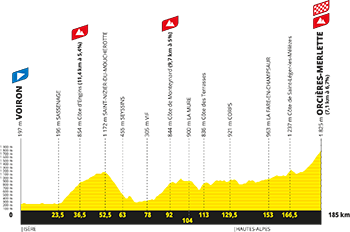
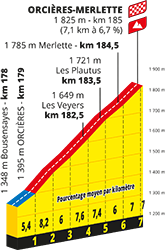
19/ Friday, July 24, 2026 - Gap > Alpe d'Huez - 128 km
After the high-altitude finish in the Hautes-Alpes the day before, the stage from Gap and the following one will be a crescendo. At 128 km, it's the shortest road stage of the Tour de France 2026, but far from easy. It's an ultra-dynamic stage, as the Tour organizers say, with the Col Bayard climb (^ 1,246 m / 5.1 km at 7.2%) at the start, and some twenty kilometers further on, the Col du Noyer summit (^ 1.664 m / 7.2 km at 8.5%), then onto a plateau via Corps and Valbonnais, before tackling the climb to Col d'Ornon (^ 1,371 m / 5.4 km at 6.4%), the summit of which is less than 30 kilometers from the finish. After descending this pass, the riders will find themselves at Bourg d'Oisance, i.e. at the foot of the 21-turn climb to Alpe d'Huez (^ 1,850 m / 13.8 km at 8.1%). All this for a total positive vertical gain of 3,500 metres.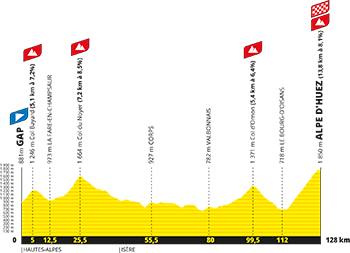
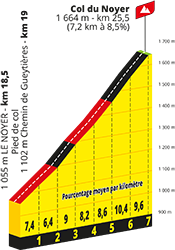
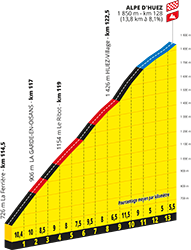
20/ Saturday, July 25, 2026 - Le Bourg d'Oisans > Alpe d'Huez - 171 km
As usual the day after a finish at Alpe d'Huez (except when it is climbed the day before the Paris stage), this stage will start in Le Bourg d'Oisans. The stage on the eve of the finish in Paris will be a "Dantesque" one, with no less than 5,600 metres of positive altitude gain. The riders soon climb the Col de la Croix de Fer (^ 2,067 m / 24 km at 5.2%). After a long descent and a passage through Saint-Jean-de-Maurienne and Saint-Michel-de-Maurienne, the Col du Télégraphe (^ 1,566 m / 11.9 km at 7.1%) - Col du Galibier (^ 2,642 m / 17.7 km at 6.9%). After the descent to Mizoën, the race then turns onto the Col de Sarenne (^ 1,999 m / 12.8 km at 7.3%) and from its summit, the junction with Alpe d'Huez is made so that the last 2 of the 21 bends remain to reach the final summit of this stage! (^ 1.850 m / 3.7 km at 6.2%)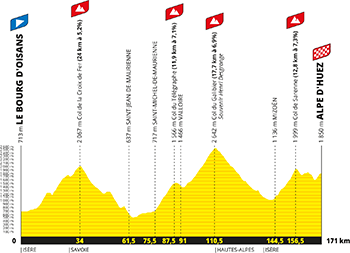
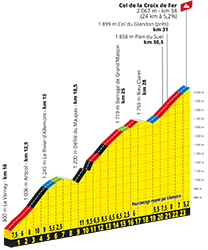
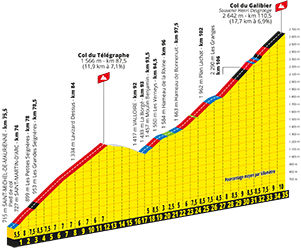
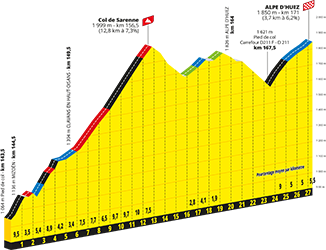
21/ Sunday July 26, 2026 - Thoiry > Paris Champs-Elysées - 130 km
The very last stage of the Tour de France 2026 will start in the Yvelines, and more precisely in Thoiry, with its zoo now known as Wow Safari Thoiry. For the rest of the stage, the route to Paris is as often uninteresting, but since this year, as a legacy of the Paris 2024 Olympic Games, the end of the stage before the finish at the Champs-Elysées had gained in interest with the passage through Montmartre and its now famous Rue Lepic. In 2026, this passage will return, but the finale of the stage will unfold a little differently. Where in 2025 there were 3 laps of the usual Champs-Elysées circuit, then a departure from the Rue de Rivoli for 3 laps including the ascent to Montmartre, in 2026 we'll again see the 3 laps of the usual Champs-Elysées circuit, but then it's from the Place de l'Etoile that the race heads towards Montmartre, and the loop is thus widened to include 3 climbs to Montmartre. With the return to l'Etoile, the finish line on the Champs-Elysées is this time 15 kilometers from the Sacré Coeur, which could allow the sprinters to get back into the game and potentially win this stage.Map of the Tour de France 2026
Here's the map with the 21 stages of the Tour de France 2026: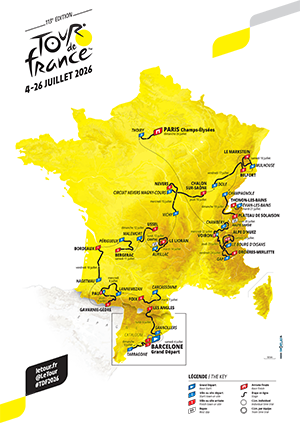
Tour de France Women with Zwift 2026
On the same occasion, the Tour de France Femmes avec Zwift 2026 was also presented. In a condensed 9-stage format, women will experience a Tour de France with a start in Switzerland and a finish in Nice:- 1/ Saturday August 1, 2026 - Lausanne ?? > Lausanne ?? - 137 km
- 2/ Sunday, August 2, 2026 - Aigle 🇨🇭 > Geneva 🇨🇭 - 149 km
- 3/ Monday, August 3, 2026 - Geneva 🇨🇭 > Poligny - 157 km
- 4/ Tuesday, August 4, 2026 - Gevrey-Chambertin > Dijon - individual time trial - 21 km
- 5/ Wednesday, August 5, 2026 - Mâcon > Belleville-en-Beaujolais - 140 km
- 6/ Thursday, August 6, 2026 - Montbrison > Tournon-sur-Rhône - 153 km
- 7/ Friday, August 7, 2026 - La Voulte-sur-Rhône > Mont Ventoux - 144 km
- 8/ Saturday, August 8, 2026 - Sisteron > Nice - 175 km
- 9/ Sunday, August 9, 2026 - Nice > Nice - 99 km
CONTINUE READING AFTER THIS ADVERTISEMENT
The map of the Tour de France Women avec Zwift 2026
Here is the map of the 9 stages of the Tour de France Femmes avec Zwift 2026: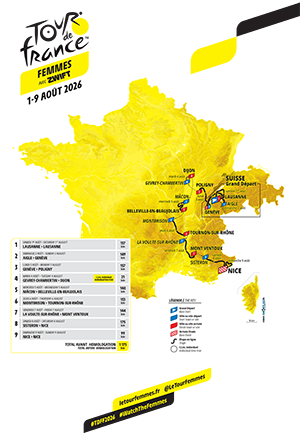
Vond u dit artikel interessant? Laat het uw vrienden op Facebook weten door op de buttons hieronder te klikken!
4 comments | 6033 views
this publication is published in: Tour de France | Tour de France 2026





 by thcman over
by thcman over
5 is the number of massifs that the Tour de France 2026 will visit, with the Pyrenees (stages 3 to 6), the Massif Central (stage 10), the Vosges (stage 14), the Jura (stage 15) and the Alps (stages 16 to 20) in that order.
During its visits to these massifs, the race will climb no fewer than 7 passes and climbs that have never before been climbed by the Tour de France:
- Côte de Begues on stage 2
- the Gavarnie-Gèdre climb at the finish of stage 6
- the Col de la Griffoul on stage 10
- Col du Page and Col du Haag on stage 14
- Plateau de Solaison at the finish of stage 15
- the Col de Sarenne on its south-eastern side on stage 20, before the finish at Alpe d'Huez (previously, the Col de Sarenne had been climbed on the other side, after Alpe d'Huez, in 2013, to descend to Bourg d'Oisans and begin a second and final ascent of the Alpe d'Huez).
In all, the Tour de France 2026 features no fewer than 30 passes or climbs or high altitude finishes classified as second, first or hors catégorie (compared with 26 in 2025, 27 in 2024 and 30 in 2023). A look at their distribution shows once again that everything is concentrated in the Alps, since there is 1 in Catalonia 🇪🇸, 6 in the Pyrenees, 4 in the Massif Central, 5 in the Vosges, 1 in the Jura and no less than 13 in the Alps!